Who was Leonardo da Vinci?
Leonardo was born in 1452, apparently in a Tuscan village called Anchiano, not far from Vinci, and died in France in 1519. He may be best known as an artist but he was also an engineer, thinker and inventor.

“Even talking about Leonardo as an artist and Leonardo as an engineer has little sense if we try to think like a Renaissance man, because everything was so much connected at that time,” says Claudio Giorgione, curator at the Leonardo da Vinci National Science and Technology Museum in Milan.
Leonardo’s most famous paintings include the Mona Lisa and the Last Supper, while his drawings such as Vitruvian Man – showcasing the proportions of the human body – have become instantly recognisable.
As copies of Leonardo’s notes and journals, such as the astonishing 12-volume Codex Atlanticus, became widely disseminated, appreciation of his observations, theories, and sketches of anatomy and contraptions also became famous. These included ideas that would only become a reality hundreds of years later, such as flying machines – although Giorgione warns against embracing hindsight and seeing Leonardo as a visionary.
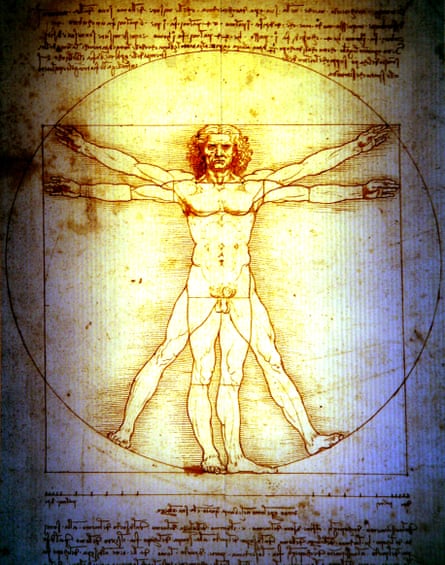
Perhaps surprisingly Leonardo wrote his diaries in the mirror image of normal script, although quite why remains something of a mystery.
Where did he cut his teeth?
As the illegitimate son of a well-to-do and rising notary – someone involved in drawing up and witnessing legal documents – Leonardo was not able to follow in his father’s footsteps, but the boy’s artistic talents were spotted and an apprenticeship was sought in Florence.
As a teenager Leonardo trained in the workshop of the famous Renaissance artist Andrea del Verrocchio where all sorts of activities were on the go from drawing and painting to sculpture and metalwork – including making armour. While still training with Verrocchio, it is thought that Leonardo could have been involved in making the huge gilded copper ball that sits on top of the cathedral of Santa Maria del Fiore – he was certainly on the scene when it was hoisted into place in 1471 and made sketches of the lifting devices used.
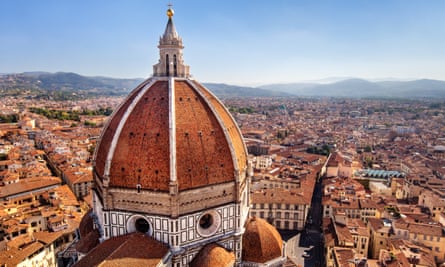
“The artist engineer is a known figure in Renaissance Italy,” says Prof Martin Kemp, a world-leading expert on Leonardo from the University of Oxford. In 1472 Leonardo was registered as a painter his own right, although he continued to collaborate with Verrochio.
Did Leonardo see himself as painter or engineer?
A bit of both. He was certainly good with a brush: among his commissions, in the late 1470s, Leonardo was asked to paint an altarpiece for a civic palace and was later commissioned by a group of monks to paint a scene of the Adoration of the Magi.
But he had an eye for opportunities. Hoping to work for Ludovico Sforza, the Duke of Milan, in the early 1480s Leonardo moved to Milan and wrote a letter boasting of his prowess as a military engineer, including such lines as “Should the need arise, I will make cannon, mortar and light ordnance of very beautiful and functional design that are quite out of the ordinary.” His abilities as a painter come bottom of the letter in a throwaway line. “He was certainly pitching himself as an engineer,” says Kemp. While it is not clear if the letter swung it, Leonardo was later to be found working at the Duke’s court.
Was the mix of artist and scientist unique?
Certainly not – many artists would also have been architects or engineers. But Leonardo was unusual in being not just a jack of all trades, but a master of several. “The versatility as such would not have been altogether surprising,” says Kemp. “[But] I think the range and skill across the board would have surprised people enormously and he had a lot of accomplishments, including as a musician.”
And his talents, and studies, went further into maths, Latin and beyond. “He also went into what we would now call science, ie more theoretical, more experimental, more exploratory areas,” says Kemp. And while other artists might have been probing some aspects of anatomy – muscles, bones, tendons – Leonardo took the study to a new level.
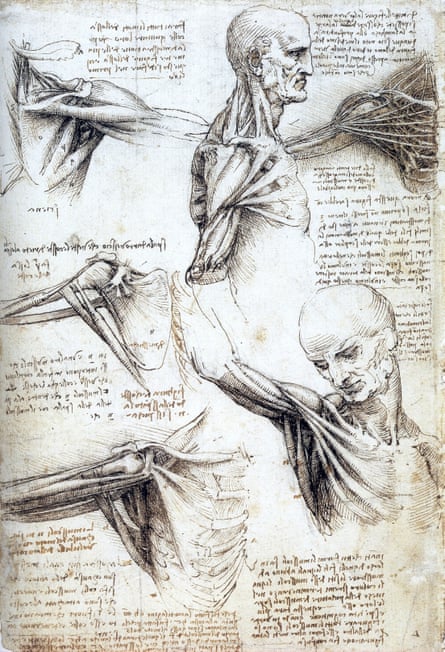
“At one point he draws the network of nerves in the shoulder and upper torso called the brachial plexus and he says on one of his diagrams this is as necessary for a good draughtsman as is the conjugation of Latin words for the good grammarian.”
But as Giorgione points out, Leonardo’s myriad talents were underpinned by a supreme skill: his drawing. “Leonardo was not the only one to draw machines and to do scientific drawings, many other engineers did that, and very often the object of the representation is the same, but what Leonardo did better than others is to make a revolution of the technical drawing,” he says.
So what was his goal?
“By the late 1480s, his aim was to understand how nature works – which is rather a big ambition – but he was looking at a fundamental set of mathematical laws, including optics and including the actions of the human body – and he saw that as a unified enterprise,” says Kemp.
That might explain why many of his ideas for machines were rooted in nature – for example his idea of a flying machine changed over time as he began to look at the way birds fly, an approach we now call biomimicry.
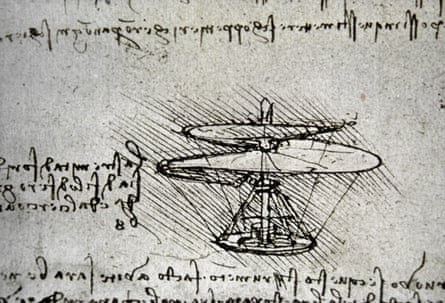
“If he looked at plants he looked at branching and came up with a law for the branching of plants which he then equates to the branching of rivers and the branching of blood vessels,” says Kemp. “So it is a continuous spectrum of analogous things he was looking at in nature.” Giorgione adds that Leonardo was hoping to unify painting, architecture and engineering with thinking and writing.
“But that was not easy because the world of the mechanical arts and the world of the liberal arts, so the arts of thinking, were separated at that time,” he says.
Did he ever turn his drawings into tools and machines?
It wasn’t all just pen-and-paper musings. “There is evidence that he had tested the wings for his flying machine to see how much lift he could get,” says Kemp, adding that in a collection of Leonardo’s writings known as the Codex Leicester – owned by Bill Gates and about to go on show at the British Library – there is evidence that he had specially designed tanks constructed so that he could explore various aspects of fluid dynamics.
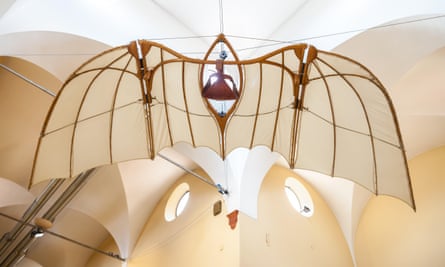
He also made a glass model of part of the heart to explore its function. The use of experimental apparatus at such a time, Kemp adds, is extraordinary. “He was emphasising all the time you must rely upon experience, not just book learning, you need hands-on experimental knowledge,” says Kemp.
Was he always right with his new scientific theories?
His thoughts were, at times, spot on: not least he pushed back against the idea that fossils unearthed on mountains were the result of a great, biblical flood. He also made discoveries about how blood moves through blood vessels and the role of valves. But he did not realise that the blood circulates. “He was not always right and that is good because it makes him a human and not a superhuman,” says Giorgione.
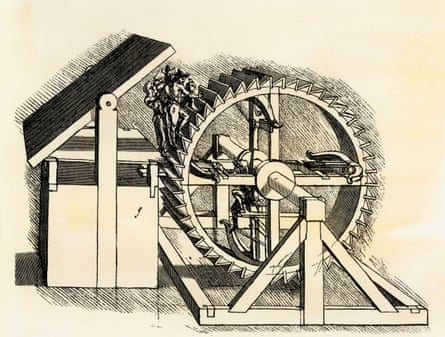
Galileo ran into trouble with authorities – did Leonardo have such difficulties?
Not exactly. In 1476 he was charged with sodomy – but a lack of evidence meant nothing came of the anonymous accusations. In terms of his work, he also seemed to avoid trouble – not least because he didn’t actually publish his notes and, as Giorgione points out, detailed observations of the world, such as those made by Leonardo, are only a part of what would later become the scientific method.
Kemp adds that when Leonardo was in Rome in his 50s working on concave mirrors for starting fires, he fell out with his German mirror makers who denounced him for his work on anatomy – which led to some frustrations in his anatomy work.
What is Leonardo’s legacy?
The question of Leonardo’s legacy, says Kemp, is something of a red herring. “It is a bit like asking what did the Romans do for us, it is essentially a self-centred question,” he says. “You can appreciate the enormous quality of what he did without necessarily saying ‘this is only worth looking at if he had an influence’.”

However, Kemp says the idea that Leonardo was known only for his paintings is a simplification, as his writings and drawings were transcribed and available to scholars, albeit a small number, throughout the centuries, suggesting they could have inspired others. Giorgione agrees noting a device sketched by Leonardo for rotating meat on a spit by using currents in the air and a small turbine – decades after he sketched his idea, a rather similar gadget turns up in an illustration of machines by another Italian engineer, Vittorio Zonca.
Why is he generally just called Leonardo, isn’t that a bit familiar?
There are a couple of reasons we get chummy when talking about Leo. As Giorgione points out, part of the reason is that we tend to talk about cultural icons by their first name – for example the Italian poet Dante Alighieri, whose full name was Durante di Alighiero degli Alighieri, is commonly just referred to as Dante. Galileo Galilei is also known by his first name. But there is another reason – Leonardo doesn’t have a “proper” surname in the modern sense as it simple refers to the area he and his family came from. “In Italian it doesn’t work to say ‘da Vinci’,” says Giorgione.
What next?
If you fancy finding out more about Leonardo, why not visit one of the many exhibitions that are running in this quincentenary year?
7 June – 8 September: Leonardo da Vinci: A Mind in Motion at the the British Library, London. Explore pages from some of Leonardo’s notebooks: the Codex Leicester, the Codex Arundel and the Codex Forster.
24 May - 13 October: Leonardo da Vinci: A Life in Drawing at the Queen’s Gallery, Buckingham Palace. With more than 200 drawings by Leonardo, this offers the chance to see his take on everything from architecture to the human body.
Until 14 July: Verrocchio, Master of Leonardo at the Strozzi Palace in Florence. Find out more about Leonardo’s master as well as Verrochio’s most famous pupil.
Château du Clos Lucé in Amboise, France where Leonardo spent his last years and died is hosting a of events throughout 2019.
Until 13 October: Leonardo da Vinci Parade, National Museum of Science and Technology Leonardo da Vinci in Milan. See machine models based on sketches by Leonardo.
